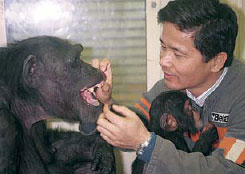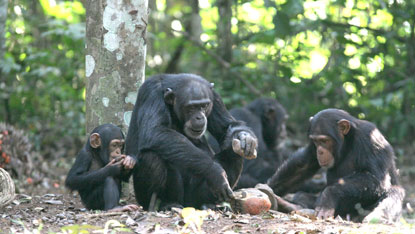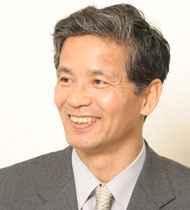The chimpanzee mind: studies in the field and the laboratory
We are 98.77% chimpanzee
Recent advances in the study of the human and the chimpanzee genome have revealed just how close the two species are. Differences at the level of the DNA are as low as 1.23%. In other words, we are 98.77% chimpanzee. The genomic difference between the two species is comparable to that between horses and zebras, who differ by about 1.5%.
The human mind is the product of millions of years of evolution, just as the human body, human society, and the human genome are. Homo sapiens is one of roughly 220 extant primate species. Comparisons between humans and other primate species present us with perhaps the best means to understanding human nature, allowing us to speculate on a number of questions. What is uniquely human? Where did humanness come from?
I have been studying chimpanzees both in Africa and in Japan. Fieldwork and laboratory work need to go hand in hand to provide us with a complete picture of the life and mind of the chimpanzee. I have called this discipline Comparative cognitive science (CCS). CCS aims to explore the evolutionary origins of human behavior and the human mind by comparing humans with closely related species. The study is thus characterized by the comparative method. Human subjects and chimpanzee subjects participate in exactly the same tests, using the same apparatus, and following the same procedure.
30 years of the Ai project

Outdoor compound of chimpanzees in KUPRI
A community of 14 chimpanzees of 3 generations inhabit an enriched, seminatural environment at the Primate Research Institute of Kyoto University (KUPRI). KUPRI is located in Inuyama, near the city of Nagoya in central Japan. My research partner here is named “Ai”, a 30-year-old female chimpanzee. I have been working with Ai since 1977, when she was just 1 year old. First, my colleagues and I focused on language-like skills in chimpanzees. We taught Ai to use visual symbols to name objects and colors, and introduced her to Arabic numerals to represent number concepts. At the age of 5, she was able to name objects, their color and number, by touching the appropriate symbols printed on the keys of a computer terminal. Follow-up studies by my colleagues and myself have covered various topics in cognition; visual acuity, form perception, face recognition, auditory-visual cross-modal matching, motion perception, short term memory, and so forth.

Triadic relationship of Matsuzawa, Ai, and the baby
The postnatal growth of the brain follows roughly the same path in humans and chimpanzees. The neonatal brain triples in size until it reaches adult levels (3.26 times larger in humans and 3.20 times in chimpanzees). This means that chimpanzees are likely to undergo developmental changes in cognition much like humans. Humans learn a variety of things through experience during postnatal development. So do chimpanzees. This provides us with a rationale for studying not only cognition in chimpanzees, but also, specifically, cognitive development following birth.
We developed a new way of studying cognitive development in chimpanzees (Matsuzawa et al., 2006, published by Springer Verlag). The method is called “participation observation”. We focus on chimpanzee infants raised by their biological mothers. The latter have a well-established long-term relationship with human researchers, as a result of which we can test the cognition of infant chimpanzees with the assistance of their mothers. In the year 2000, KUPRI saw the birth of three chimpanzee infants, all of whom are being raised by their mothers.
A series of cognitive experiments have revealed many similarities between humans and chimpanzees. For example, chimpanzee neonates, just like human neonates, show neonatal smiling. Newborns smile spontaneously with the eyes closed. Such neonatal smiling eventually turns into social smiling with the eyes open at the age of 3 months. This change is common to humans and chimpanzees. Neonatal facial imitation in which neonates imitate their mother’s facial expression, such as mouth opening or tongue protrusion is also shared between the two species. Chimpanzee infants prefer a straight-ahead gaze over an averted gaze, and can utilize gaze cues. Mutual gaze is also marked between mothers and infants in both species.
Infant chimpanzees begin to spend time away from their mothers, initially for brief periods, at around 3 to 4 months old: They start exploring the outer world, and interacting with other members of the community. Chimpanzee infants first show object-object combinatory manipulation, a precursor of tool use, at the age of 10 months, and first begin to use tools at around 2 years of age. In these and other skills, we continue to follow the infants’ cognitive development.
Field study of the chimpanzee mind
A community of 12 chimpanzees of 3 generations inhabit the forests at Bossou, Guinea, West Africa. KUPRI researchers have been studying these chimpanzees for 30 years. Bossou chimpanzees are well known to use a pair of stones as hammer and anvil to crack open nuts. Since 1986, I have been visiting Bossou once a year to explore developmental changes in tool use technology. The technique is typically mastered at the age of 4 to 5 years, but it takes another 5 years for it to reach the refined level of adults.
We have also found many other interesting examples of chimpanzee tool use at Bossou, including fishing for ants with a stick, using leaves for drinking water, scooping algae floating on a pond with the help of a flexible stick, and using a palm petiole as a pestle to pound the top of the tree to obtain the juicy fiber inside. These tools are essential for the chimpanzees’ survival. Our long-running studies have illuminated many interesting aspects of these behaviors, such as the existence of critical periods for the learning of the skills, the possession and transportation of tools, and so forth.
Our combination of laboratory and field studies have revealed a unique mode of social learning in chimpanzees. Referred to as “Education by masterapprenticeship”, this mechanism is characterized by three main behavioral attributes: 1) Infants’ prolonged exposure to adult behavior based on the strong mother-infant bond, 2) Lack of active teaching (no formal instruction, and no positive/negative feedback from the mother), and 3) The infants’ intrinsic motivation to copy the mother’s behavior.
Each chimpanzee community in the wild has its own unique set of cultural traditions. Through education by masterapprenticeship, chimpanzees seem able to pass knowledge and skills from one generation to the next, thereby maintaining their community’s cultural repertoire.
SAGA: Conservation and welfare
Chimpanzees are an endangered species. They inhabit the tropical forests of Africa, where their numbers have decreased from around 600,000 in the 1960s to less than 200,000 at present. There are three main reasons for this dramatic drop in numbers: deforestation, illegal hunting, and contagious diseases such as Ebola and influenza. All three are the result of human activity.
There are 348 chimpanzees housed in 56 facilities (mainly zoos) in Japan. One third of zoos keep only one or two chimpanzees, often in smaller-thanadequate spaces. Chimpanzees need to live with parents, siblings, and other conspecifics, under conditions that ensure high levels of welfare.

Stone tool use by chimpanzees at Bossou, Guinea
We launched SAGA (Support for African/Asian Great Apes) in 1998. SAGA is a consortium of those persons and NGOs who are concerned about the great apes chimpanzees, gorillas, and orangutans. SAGA has promoted conservation in the species’ natural habitats, welfare and enrichment in the captive environment, and furthering scientific understanding through non-invasive techniques.
Chimpanzees have been used for biomedical research on, for example, AIDS, hepatitis, and malaria. There are still more than 1500 chimpanzees kept in biomedical laboratories across the USA. In Japan, three pharmaceutical companies have in the past used chimpanzees for biomedical research. However, all invasive studies ceased from October 2006, thanks to the SAGA movement. We are now setting up a sanctuary for those 79 chimpanzees who were once the subjects of biomedical research. I want to follow my dream: One day, I hope to see humans and chimpanzees living together as neighbors and evolutionary cousins.

Tetsuro Matsuzawa
Born in 1950
Field of specialization: Comparative cognitive science
Completed masters program at Graduate School of Letters, Kyoto University
D.Sc., Kyoto University
Director, Primate Research Institute, Kyoto University
URL : Primates research institute Kyoto University (External Link)
Today, thanks to the progress of science, it is increasingly acknowledged that all life on this planet, including human life, is linked together by the common language of DNA. Through my research on chimpanzees, I am striving to broaden people’s understanding of primates, and all life in general.
Prof. Matsuzawa, through his cognitive research of chimpanzee Ai over a period of nearly 30 years, is probing the evolutionary origins of the mind and behavior of human, Homo sapiens. He is internationally renowned as the pioneer of a new research field called 'comparative cognitive science'.
The starting point of Prof. Matsuzawa's research was to philosophically question what it is for a person 'to know'. In his quest for an answer, he enrolled in the philosophy department of Kyoto University's Faculty of Letters in 1969. Following on from this, he conducted research on human vision and then on brain functions in rats. His research led him to conclude that if he started research on chimpanzees whose genetic makeup is the closest to humans, he could better understand the mind and nature of human cognition.
Prof. Matsuzawa is also a skilful mountain climber, and has climbed the peak of the eight-thousander Mt. Shishapangma. While a university student, he belonged to the mountain climbing club and spent about a third of the year trekking mountains. He says he acquired through mountain climbing much of the grounding required for a researcher, such as the desire to strive for originality to explore untrodden ground, and the selfdiscipline necessary for the achievement of goals.
In 2000 when Ai's son Ayumu was born, Prof. Matsuzawa's interest was broadened to consider how chimpanzees hand down knowledge and technology to the next generation. Since 1986 he has also devoted a lot of his time to helping restore the savannah and regenerate the forests in Bossou, West Africa, where he has been conducting research into the lives of chimpanzees. Prof. Matsuzawa is warmly observing, chimpanzee, man, and our planet with equal devotion.

